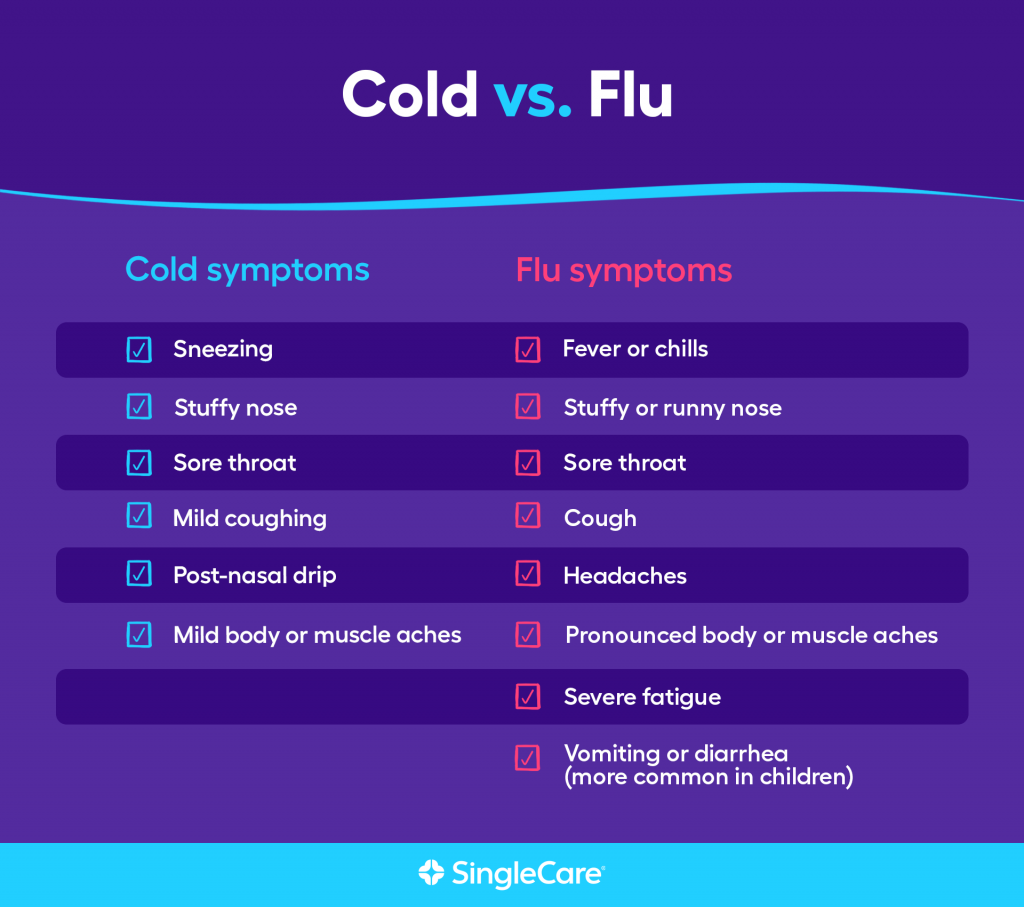What is the flu? | Symptoms | Complications | How long does it last? | Transmission | Treatment | Prevention | Reinfection
Each fall, while stocking up on back-to-school supplies, raking leaves, and indulging in pumpkin spice, many American families start thinking about the flu—and how to avoid it. And this year, that’s more likely true than ever as scientists have warned about a “twindemic” with the typical flu season hitting at the same time as the COVID-19 pandemic.
In a normal year, up to 20% of the population will get sick with the flu, according to the Centers for Disease Control and Prevention (CDC). Peak flu season is December through February, but some years it can last until May.
Just because it’s on your radar doesn’t mean you know how the virus spreads or how to manage it. For that, it helps to understand why it comes back each year, the different strains, and how to deal with symptoms.
What is the flu?
The influenza virus, commonly called the flu, is “a seasonal infectious disease that can affect the throat, nose, and sometimes lungs and which results in fever, body aches/chills, and overall fatigue,” says Saba Hamiduzzaman, MD, an internal medicine physician and a pulmonologist at Loma Linda University Health. It is a contagious respiratory tract infection that can cause mild to severe illness and, in some cases, death.
Types of flu viruses
Although we refer to this seasonal sickness as the flu, there are actually four types: A, B, C, and D influenza viruses.
It’s only “the influenza A and B viruses that routinely spread in people that are responsible for seasonal flu epidemics each year,” says Dr. Hamiduzzaman.
Influenza A viruses are further divided into subtypes based on two proteins on the surface of the virus: hemagglutinin (H) and neuraminidase (N). While many different H and N subtypes have been identified, only a few routinely circulate in humans—including H1N1 and H3N2. The well-known Avian flu, spread among aquatic birds, and swine flu, spread among pigs, also fall in this category. These types of new and different influenza A viruses can cause an influenza pandemic if able to successfully infect humans.
Influenza B viruses are not divided into subtypes like A, but circulate in lineages and strains. Today, influenza B viruses belong to one of two lineages: B/Yamagata and B/Victoria.
Influenza type C viruses generally cause only mild respiratory illness.
Influenza D viruses mostly affect cattle.
Flu misnomers
There are other so-called flus that, name aside, have nothing to do with the influenza virus.
This includes stomach flu, medically known as viral gastroenteritis, an intestinal disease that can last from a couple days to as many as 10. You can contract it from an infected person or contaminated food or water. Symptoms include watery diarrhea, abdominal cramps, nausea or vomiting, and sometimes fever.
Keto flu is another faux-influenza. This occurs in people following the keto diet—eating minimal sugars and starches in favor of healthy fats and protein. The body burns fat for fuel in the absence of the glucose that carbohydrates provide. The result is symptoms similar to influenza, including nausea, weakness or fatigue, stomach cramps, dizziness and poor concentration. These symptoms typically last a week.
Then there is brain flu. In this case, a brain infection causes encephalitis, which can present as mild flu-like symptoms such as headache, fever, and muscle soreness. It requires medical care by a doctor or healthcare provider.
What are the symptoms of the flu?
The first sign of the flu can be extreme fatigue. People may feel so tired that daily activities become a challenge. Body aches and chills are common symptoms as the flu sets in, along with a persistent cough and sore throat.

A cold vs. the flu
Many people have a hard time differentiating between flu symptoms and a bad cold. “The symptoms of a cold are milder and usually associated with a runny or stuffy nose and sore throat,” Dr. Hamiduzzaman explains. “Patients with the flu will feel very run down and symptoms will be more pronounced than with the cold.”
Cold symptoms typically have a gradual onset and may include:
- sneezing
- stuffy nose
- sore throat
- mild coughing
- post-nasal drip
- mild body or muscle aches
Flu symptoms typically have a sudden onset and may include:
- fever or chills
- cough
- sore throat
- stuffy or runny nose
- headaches
- pronounced body or muscle aches
- severe fatigue
- vomiting or diarrhea, which is more common in children with the flu
Cold symptoms usually last for about a week. Unfortunately, getting over the flu can take time. Symptoms typically appear one to four days after exposure to the virus. While they sometimes improve in two to five days, many people are sick for as long as five to seven days—sometimes longer. Plenty of rest, fluids, and over-the-counter anti-inflammatory pain relievers may help.
COVID-19 vs. the flu
What about COVID-19 symptoms? Well, they can be similar to the flu, including fever, cough, body aches, and fatigue. Getting the flu shot and protecting yourself from catching it in the first place, is one way to rule out the flu. Ultimately, though, you’ll need to speak with your healthcare provider about testing for both flu and COVID-19 to determine what you have and the best course of managing symptoms. Read more about COVID-19 vs. the flu here.
RELATED: Does the flu shot or Tamiflu prevent COVID-19?
How deadly is the flu?
Most healthy people who get the flu endure just a few days of feeling crummy. But the flu can be deadly. In the U.S., the flu affects more than 3 million people annually. While statistics vary each season, on average over 200,000 are hospitalized because of flu complications each year, and up to 50,000 can die from the virus each year.
RELATED: Flu statistics
How long does the flu last?
Ask anyone who just recovered from the flu and they might say it lasted “forever.” The symptoms may make each day feel like an eternity, but in reality, the flu is a short-term illness.
Symptoms typically appear one to four days after exposure to the virus. They can last five to seven days. Fatigue, or tiredness, however, can last longer.
Some people experience flu-related complications that extend the length of sickness, according to Victor Laluz, MD, an internal medicine physician at Loma Linda University Health. Potential flu complications include:
- bacterial pneumonia (lung infection)
- myocarditis (inflammation of the heart)
- myositis (a condition involving the inflammation of muscles)
- inflammation of the central nervous system causing seizures
- spinal cord inflammation
- Guillain-Barre syndrome (a paralyzing autoimmune disease)
“The influenza virus leads to areas of inflammation and respiratory fluid buildup which can become sites of a secondary infection,” Dr. Laluz explains.
And according to Dr. Hamiduzzaman, certain groups of patients with health problems have a high risk for serious complications:
- older adults, age 65+
- pregnant women
- people with a chronic health problem like:
- diabetes
- HIV/AIDS
- people with a weakened immune system, like those undergoing chemotherapy
How is the flu spread?
The flu spreads from person to person in a number of ways. It travels through:
- airborne respiratory droplets from coughs and sneezes
- skin-to-skin contact like handshakes and hugs
- saliva transfer from kissing or sharing drinks
- contact with a contaminated surface.
How long is the flu contagious?
You’re contagious from the day before symptoms appear until five to seven days after you start feeling sick. So, lots of people spread the flu virus before they even know they have it—or, after they think they’re better.
Some people are at a higher risk than others for contracting the flu. They include:
- young children under 5, especially those under 2
- adults over 65 years old
- pregnant women and women up to two weeks postpartum
- people with chronic medical conditions like diabetes, asthma, lung disorders, heart disease, kidney and liver disorders, blood disorders, or neurological and neurodevelopmental disorders
- Obese people with a body mass index (BMI) of 40 or greater
Each year, 70 million work days are lost due to the flu. Many workplaces urge their employees to stay home if they’re feeling sick to protect healthy coworkers—and with COVID-19 guidelines in place, your HR department may have a standard rule to follow. If not, it can be difficult to tell just how long to stay away. A good rule of thumb? Wait at least 24 hours after your fever is gone without using a fever-reducing medicine like acetaminophen (or ask your doctor!).
How to treat the flu
The best way to treat the flu is to avoid getting it in the first place. The CDC recommends the influenza vaccine for nearly everyone. This immunization will prevent most strains of the flu. And if you do manage to catch it, the shot can make symptoms less severe, and the illness shorter.
If you’ve contracted the flu, treat it with bed rest, fluids—including water, juice, and warm soups —and plenty of sleep to help your immune system fight the infection. Over-the-counter pain relievers such as acetaminophen and ibuprofen can help with fever, body aches, and headache pain.
Most people can recover from the flu without medication, but some healthcare providers may prescribe antiviral drugs to soothe symptoms. “There are medications that can be taken to more rapidly clear the virus from the body and shorten the duration of symptoms,” says Dr. Laluz. “The most commonly used is Tamiflu, or oseltamivir, and Xofluza, or baloxavir. They must be used within the first 48 hours of flu symptoms to work and they should generally be used in adults.” These medications are strongly indicated if the flu symptoms are very severe or the patient is in the high risk category based on co-morbidities.
Other at-home remedies include throat lozenges, cough expectorants, moist steam, saline nose or throat drops, or a humidifier if you have dry air.
RELATED: Influenza treatments and medications
How to prevent the flu
To lessen your risk of infection, make sure to get a flu shot in early fall every year. In addition, Dr. Laluz recommends the following:
- Wash your hands frequently near coughing or sick people.
- Clean surfaces that you touch with your hands with an antiviral cleanser such as an alcohol-based cleanser.
- Wash your hands before you eat.
- Avoid touching your face unnecessarily, as this can put germs in your nose or mouth.
- Wear a mask in public areas.
RELATED: More ways to prevent the flu
Once you get the flu, can you get it again?
Unlike some viruses, you can get the flu more than once. In other words, you aren’t immune from getting it again. That’s because of what Dr. Laluz calls “the antigenic shift.” Different strains of the flu virus combine to form an entirely new one. There is also antigenic drift, in which small changes over time may produce a virus that the body no longer recognizes and is therefore unable to mount an immune response. The composition of the flu vaccine is analyzed yearly to monitor for these changes in circulating viruses and is updated accordingly.
“Repeated immunization is advised to increase the chances that your immune response will prevent influenza infection each year,” he says. Bottom line: Make your flu vaccination an annual habit.











